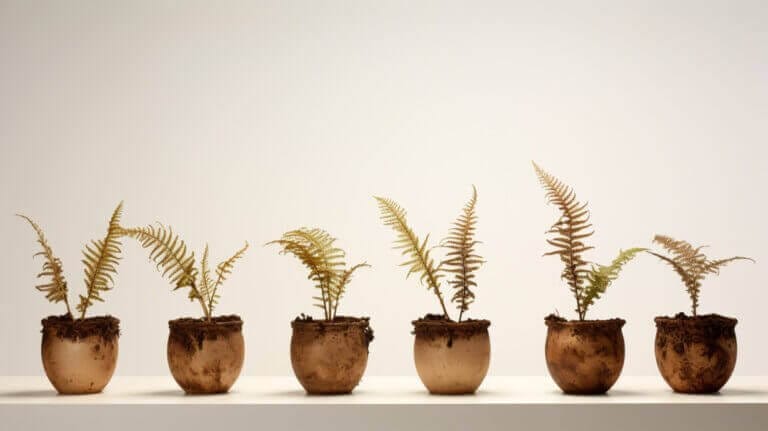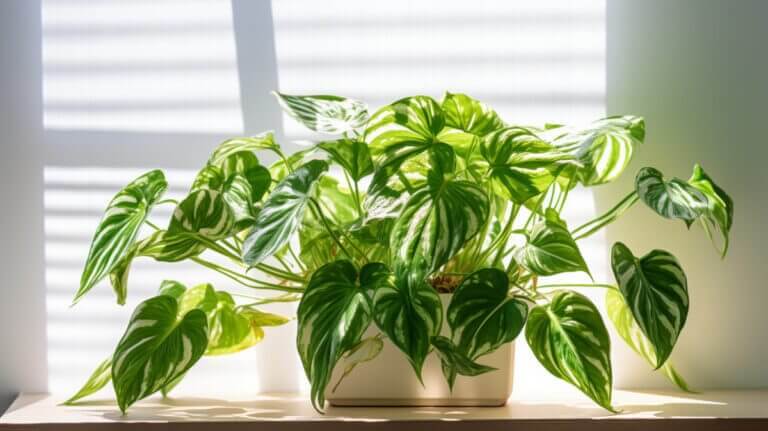Achieving Maximum Growth With Your Calathea Plant: Light, Soil And Water Needs
Calathea houseplants are known for their captivating foliage patterns, making them a perfect addition to any room. To ensure maximum growth and keep your Calathea thriving, it’s important to understand their light, soil, and water needs.
Key Takeaways:
- Proper lighting is essential for vibrant colors and patterns in Calathea plants. They prefer medium to bright indirect light, mimicking their natural habitat under a forest canopy.
- Calathea plants thrive in organically rich, well-draining soil with a slightly acidic to neutral pH. Regular watering to keep the soil moist but not saturated is crucial for their growth.
- Maintaining humidity levels of at least 50% is essential for Calathea’s well-being. Using a humidifier or placing the pot on a tray filled with water and stones can help achieve the desired humidity.
- Fertilizing Calathea plants with a half-strength liquid balanced fertilizer monthly during the growing season promotes lush and healthy growth.
- Common varieties of Calathea include Calathea orbifolia, Calathea ornata, and Calathea lancifolia, each with its own unique foliage patterns and colors.
Understanding Calathea Plant Care
Calatheas, often referred to as prayer plants, are beloved for their unique leaf movement called nyctinasty and their captivating foliage patterns. To ensure these plants thrive, proper care is essential. This section will provide you with all the necessary information on caring for your Calathea, including watering, soil requirements, and lighting needs.
When it comes to watering your Calathea, it’s important to strike the right balance. These plants prefer to be kept consistently moist but not overly saturated. A good rule of thumb is to water when the top inch of soil feels dry to the touch. Additionally, using filtered or distilled water is recommended to avoid any mineral buildup that could harm the leaves.
The soil requirements for Calathea are also crucial for their well-being. These plants thrive in organically rich, well-draining soil with a slightly acidic to neutral pH. Using a potting mix specifically formulated for houseplants or adding peat moss to the soil can help create the ideal growing conditions for your Calathea.
Lastly, understanding the lighting needs of your Calathea is essential for its overall health. These plants prefer bright indirect light, mimicking the dappled sunlight they receive in their natural habitat under a forest canopy. While they can tolerate lower light conditions, providing medium to bright indirect light will help maintain the vibrant colors and patterns of their foliage.
Calathea Orbifolia Care
One popular variety of Calathea is the Calathea Orbifolia, known for its large round leaves with beautiful silver stripes. Caring for Calathea Orbifolia is similar to other Calathea varieties, with attention to watering, soil, and light conditions. The humidity levels should be kept high, and misting the leaves or using a humidifier can help achieve this. Additionally, regular fertilization during the growing season, using a balanced liquid fertilizer at half strength, can promote the lush growth of your Calathea Orbifolia.
| Aspect of Care | Requirements |
|---|---|
| Watering | Keep soil moist, but not saturated. Water when the top inch of soil feels dry. |
| Soil | Organically rich, well-draining soil with a slightly acidic to neutral pH. Use a potting mix formulated for houseplants or add peat moss to the soil. |
| Lighting | Bright indirect light, mimicking dappled sunlight. Can tolerate lower light conditions, but medium to bright indirect light is ideal. |
| Calathea Orbifolia Care | Additional care for Calathea Orbifolia includes maintaining high humidity levels, regular misting or using a humidifier, and fertilizing with a half-strength balanced liquid fertilizer during the growing season. |
Light Requirements for Prayer Plant(Calathea)
Proper lighting is crucial for the health and growth of your Calathea plants. These beautiful houseplants prefer filtered light or shade, mimicking the dappled sunlight they receive in their natural habitat under a forest canopy. While they can tolerate low light conditions, providing them with medium to bright indirect light will help maintain their vibrant colors and intricate patterns.
It is important to note that direct sunlight can scorch the delicate leaves of Calathea plants, so it is best to keep them away from windows with direct sunlight exposure. Instead, place them in a location that receives bright, indirect light throughout the day, such as a few feet away from a north or east-facing window.
Choosing the Right Location
When selecting a location for your Calathea plant, consider the light levels in your home. If you have a room with low light conditions, such as a basement or a room with minimal windows, Calatheas can still thrive. However, you may need to provide supplemental artificial lighting, such as fluorescent or grow lights, to ensure they receive adequate light for healthy growth.
On the other hand, if you have a room with bright, direct sunlight, it is best to place your Calathea in a spot where it will receive filtered light or diffuse light throughout the day. You can achieve this by using sheer curtains or placing the plant a bit away from the window, ensuring it is shielded from direct sunlight.
Signs of Improper Lighting
If your Calathea is not receiving enough light, it may show signs of stress. Look out for pale or faded leaves, slow growth, or a lack of vibrant patterns. If the plant is receiving too much light, the leaves may become bleached or scorched, and it may also experience leaf curling or wilting.
By understanding and providing the right light requirements for your Calathea plants, you can ensure their optimal growth and ensure their foliage stays beautiful and vibrant.
| Light Level | Recommendation |
|---|---|
| Low light | Calatheas can tolerate low light conditions, but their growth may be slower and their colors less vibrant. Supplemental artificial lighting may be necessary. |
| Bright indirect light | Calatheas thrive in bright, indirect light. Place them a few feet away from a north or east-facing window to provide the ideal light conditions. |
| Direct sunlight | Avoid exposing Calatheas to direct sunlight as it can damage their leaves. Filter the light with sheer curtains or place them away from windows with direct sunlight. |
Soil and Water Needs of Calathea
Proper soil and water management are essential for the healthy growth of your Calathea plant. Understanding the specific needs of these beautiful foliage plants will ensure their long-term thriving.
Soil Requirements
Calatheas prefer organically rich soil that is well-draining. A mixture of peat moss, perlite, and potting soil provides the ideal environment for their roots to thrive. The soil should have a slightly acidic to neutral pH, around 5.5 to 6.5, which mimics the conditions in their natural habitat.
Watering Techniques
Proper watering is crucial for the health of your Calathea. It’s important to keep the soil consistently moist but not waterlogged. Overwatering can lead to root rot and other issues, while underwatering can cause the leaves to curl or dry out. You can check the moisture level by inserting your finger into the soil about an inch deep. If it feels dry, it’s time to water.
- Water your Calathea thoroughly until the excess water drains out from the bottom of the pot.
- Avoid letting the plant sit in standing water, as this can lead to root rot.
- Filtered or distilled water is preferable, as tap water may contain minerals that can damage the leaves.
- Ensure that the pot has drainage holes to prevent water from accumulating.
Table: Comparison of Calathea Watering Methods
| Watering Method | Advantages | Disadvantages |
|---|---|---|
| Bottom Watering | – Prevents excess moisture on the foliage – Allows the roots to absorb water slowly and effectively | – May lead to inadequate watering if not done correctly – Requires monitoring to ensure the water level is sufficient |
| Top Watering | – Provides direct moisture to the soil – Allows for a visual check of soil moisture level | – Runs the risk of overwatering if not done carefully – May result in water splashing on the foliage, increasing humidity needs |
| Moisture Meters | – Provides an accurate reading of the soil’s moisture level – Takes the guesswork out of watering | – Can be costly – Requires regular calibration for accurate readings |
Tips for Humidity and Fertilizing Calathea
Calatheas thrive in environments with high humidity levels, which mimic their natural habitat in tropical rainforests. To create the ideal humidity for your calathea, you can use a humidifier or place the plant pot on a water-filled tray with stones. This method allows evaporating water to increase the humidity around the plant. Maintaining a humidity level of at least 50% will help prevent the leaves from drying out and promote optimal growth.
Fertilizing your calathea is essential to provide the necessary nutrients for healthy foliage and growth. During the growing season, which typically spans from spring to summer, you can fertilize your plant once a month. Choose a balanced liquid fertilizer and dilute it to half-strength to avoid overfeeding. Applying the fertilizer directly to the soil around the plant’s roots will ensure efficient nutrient absorption. Take care not to over-fertilize, as this can lead to nutrient burn and damage the plant.
| Humidity Tips | Fertilizing Tips |
|---|---|
|
|
Common Calathea Varieties
Calatheas, with their stunning foliage patterns, come in a variety of different species, each offering unique colors and designs. Here are three popular calathea varieties:
1. Calathea Orbifolia
The Calathea Orbifolia is known for its oversized green leaves with pale silver stripes. The contrast between the dark green and the silver stripes creates an eye-catching display, making it a favorite among plant enthusiasts. This variety thrives in bright indirect light and requires a well-draining soil to prevent root rot.
2. Calathea Ornata
Featuring bold pink stripes on its dark green leaves, the Calathea Ornata is a striking variety that adds a touch of elegance to any indoor space. It prefers moderate to bright indirect light and slightly moist soil. Regular misting or using a humidifier can help maintain the humidity levels it craves.
3. Calathea Lancifolia (Rattlesnake Plant)
The Calathea Lancifolia, also known as the Rattlesnake Plant, boasts long, slender leaves with patterns resembling snake skin. The dark green leaves are marked with wavy lines of lighter green and have a purplish underside. This variety thrives in medium to bright indirect light and requires well-draining soil.
Note: Images are for illustrative purposes only and may not accurately represent the exact appearance of each variety.
Propagating and Repotting Calathea
Propagating and repotting your Calathea can help ensure the continued growth and health of your plants. Here are some tips and guidelines to follow:
Propagating Calathea
One way to propagate your Calathea is through divisions. When your plant has grown large enough, gently remove it from its pot and separate the root ball into smaller sections. Each division should have at least one or two healthy shoots and a good amount of roots. Plant each division in its own pot with fresh potting mix and provide the same care as the parent plant.
Another method is through tip cuttings. Select a healthy, non-flowering stem and cut it just below a node. Remove the lower leaves, leaving only a few near the top. Plant the cutting in a small container filled with a well-draining mix. Place the container in a warm and humid environment, and mist the cutting regularly. After a few weeks, new roots should begin to develop.
Repotting Calathea
It is recommended to repot your Calathea every few years to provide fresh soil and adequate space for growth. When repotting, choose a pot that is slightly larger in diameter than the current one. Use a well-draining potting mix that retains moisture without becoming waterlogged.
Before repotting, thoroughly water your plant to help ease the removal from the old pot. Gently tap the pot to loosen the root ball, then carefully lift the plant out. Place the Calathea in the new pot, making sure it sits at the same depth as before. Fill in the gaps with fresh potting mix, firming it gently around the roots. Water the plant thoroughly after repotting to help settle the soil.
Troubleshooting Common Calathea Issues
When caring for your calathea, it’s important to be aware of some common issues that may arise. By understanding and addressing these problems, you can keep your plant healthy and vibrant.
One common issue is brown, crispy leaf edges. This can be caused by inconsistent watering, where the soil becomes too dry between waterings, or by improper light levels. To prevent this, make sure to water your calathea regularly, keeping the soil moist but not saturated. Additionally, provide your plant with the right amount of light – bright indirect light is best for calatheas.
Another potential problem is yellowing or browning leaves. This can be a sign of overwatering or poor water quality. Calatheas prefer filtered or distilled water, as tap water may contain minerals that can harm the leaves. Ensure you’re providing your plant with the right type of water and avoid overwatering by allowing the top inch of soil to dry out between waterings.
Lastly, calatheas may also suffer from pests such as spider mites or mealybugs. These tiny creatures can cause damage to the foliage and affect the overall health of your plant. To combat pests, regularly inspect your plant for any signs of infestation and treat accordingly with insecticidal soap or neem oil.
FAQ
How do I care for a Calathea plant?
Caring for a Calathea plant involves providing the right amount of light, water, and humidity. The plant needs bright indirect light, and the soil should be allowed to dry out between waterings. Rotate your plant every few weeks to ensure even growth.
What type of fertilizer should I use for my Calathea plant?
Calathea plants generally do well with a balanced houseplant fertilizer. During the growing season, spring and summer, you can fertilize your Calathea once a month. Be sure to follow the package instructions to avoid over-fertilizing.
How do I treat a Calathea plant with yellow leaves?
Yellow leaves on a Calathea plant can be a sign of overwatering or a lack of nutrients. If the plant is overwatered, allow the plant to dry out before watering again. If the plant is lacking nutrients, apply a balanced houseplant fertilizer according to the package instructions.







